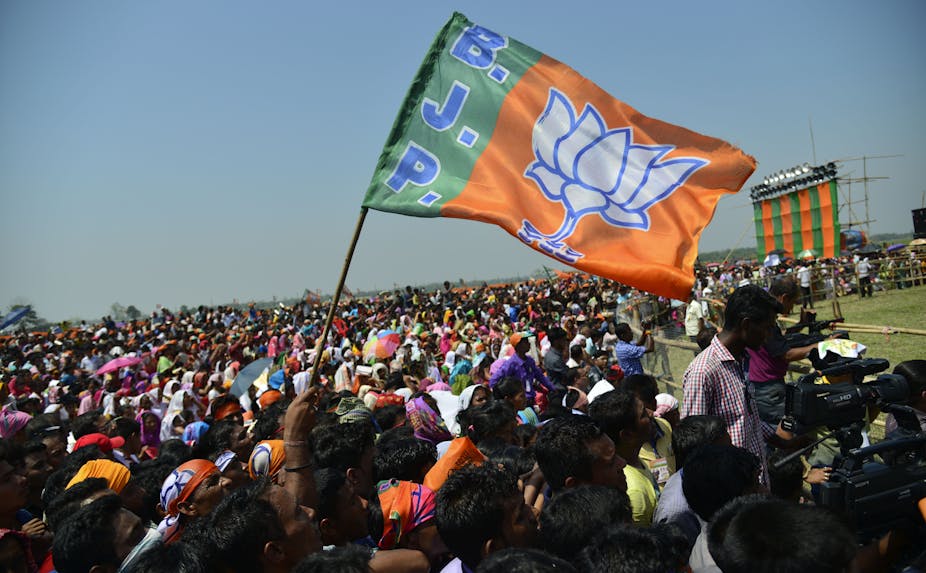Elections to the state legislative assemblies have just got underway in India. Throughout April and May, voters in five of the country’s 29 states will nominate representatives to the country’s Upper House of Parliament. And for Prime Minister Narendra Modi, these elections will be decisive in determining how much influence his government actually wields.
Out of the 250 members of the Indian Parliament’s Upper House 238 are nominated by state legislatures, of which Modi’s Bharatiya Janata Party (BJP) holds only 64 out of the 250 seats. To try and strengthen its hand, Modi himself is getting very involved in state-level election campaigns, which are normally left to regional leaders.
Based on previous elections, his involvement probably won’t do him many favours. He got closely involved with the 2015 campaigns in Delhi and Bihar, but in both states, the BJP lost out to smaller regional coalitions. Those losses were a big boost to Modi’s opponents, so it’s crucial that the BJP wins at least one of the four large states voting this time around: Assam, Kerala, West Bengal, and Tamil Nadu.
The BJP’s best chance is in the northeastern state of Assam, whose history of sectarian conflicts between a Hindu majority and a Muslim minority make it a major political opportunity for the Hindu nationalists.
The BJP candidate there is the party’s newly appointed chief, Sarbananda Sonawal. He has won widespread support by appealing to strong Hindu nationalist feelings and stoking up the communal and identity tensions that have ripped through Assam for decades.
Since 2011, Sonawal has stirred up fears over unemployment, and has been at the forefront of a campaign against Bangladeshi immigrants to the state. Migration has allegedly increased Assam’s Muslim population to 34% of the state’s total, making it India’s second most Muslim state (after Kashmir).

Opinion polls suggest the BJP is set to snatch Assam from its main opponent, the Indian National Congress (INC), whose leader, Tarun Gogoi, has been the state’s chief minister for 15 years. That would be a stunning turn of events, not least because Assam hasn’t had a government without the backing of a Muslim constituency since the deadly anti-Muslim riots of the 1980s.
Divide and conquer
In states such as Assam, where local authorities have done little to redistribute wealth, the BJP has a good shot at outright victory, since independent Hindu-run welfare organisations affiliated with the BJP can win over minority communities by providing local social services. But in Kerala, where redistributive policies are strong, the BJP is relying mainly on the canvassing efforts of the Hindu nationalist Rashtriya Swayamsevak Sangh (National Volunteer Organisation, or RSS) to drum up support.

No BJP candidate has ever won in Kerala. In this state, politics have traditionally been fought on religious rather than caste lines, but over the past few years, the RSS has attempted to create rifts in the “monolithic Hindu vote bank”. While the RSS was rejected by the upper caste Nair community organisation, they have been actively pursuing the Ezhavas, Kerala’s traditional “toddy tappers”, workers who collect tree sap to make palm wine.
Modi himself inaugrated the Sree Narayana Dharma Meemamsa Parishad in April 2013, commemorating the Ezhavas’ historic leader – an astute political act, since this lower caste community is politically well-organised and its support potentially decisive. More recently, the celebrated tribal leader C.K. Janu has also joined the BJP fold.
And although it seems likely that the INC-led government in Kerala will be replaced by the Left Front and not the BJP, Modi’s party looks well-placed to swell its share of the vote from the tiny 6% it won in 2011.
Sometime friends
Things are rather different in West Bengal, where the BJP has a curious relationship with the state’s incumbent chief minister, the Trinamool Congress (TMC)‘s Mamata Banerjee.
Banerjee’s main voters are in rural areas. She won their support during agitations against the Communists over land in 2007, and she has retained it thanks to a “food for all” programme. She has also put an end to the anti-communist TMC-BJP partnership forged in the 1990s.
In the 1990s, the TMC relied on support from the BJP to oust the Communist Party (CPM) regime from the region, but today, Banerjee is wary of the implications of partnering with a Hindu nationalist party. Since 2011, both parties have run independently in national and state level elections. To shore up her vote against the BJP, she has made a range of ostentatious gestures to Muslims, who make up 30% of the state’s voter base, though many of them (such as her policy of handing out stipends to Imams) have been derided as brazen appeasement.

While the BJP is not strong enough to form a government in West Bengal, it has managed to supplant the CPM-INC coalition as the main anti-Banerjee force, and it has a broad support base among urban, upper caste Hindus and Hindi-speaking non-Bengalis. But while the BJP might still do well despite the collapse of its West Bengal alliance, it needs to partner up with other parties elsewhere – and hasn’t always done well.
In Tamil Nadu, it failed to secure an agreement with the All India Anna Dravida Munnetra Kazhagam (All India Anna Dravidian Progress Federation, or AIADMK), a highly influential regional and national party. Without a strong partner in the elections there, the BJP’s chances of wielding power in the state are slim.
Modi seems aware of his party’s dim prospects, as he has barely been involved in the Tamil Nadu campaign. But in the hope that the elections in the state won’t be a complete washout for the BJP, he has nonetheless spoken directly to Dalit (lower caste) constituencies who make up a fair chunk of the state’s electorate, promising them that quotas guaranteeing them jobs will not be rescinded.
For now, all eyes are on Assam, the first state to vote. And with Modi and the BJP determined to shore up their power wherever they can, the pressure is on.

